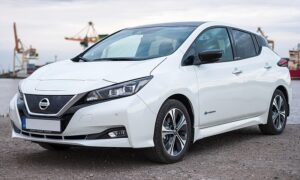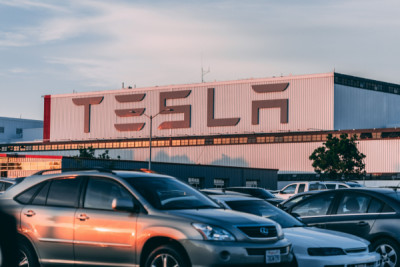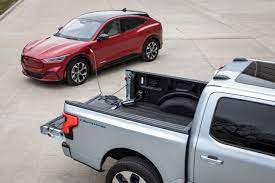
RIGA, MAY 2018 - Nissasn LEAF - fully electric zero emissions vehicle is displayed for editorial purposes.

Nissan’s 2023 Leaf is a gorgeous electric vehicle
The 2023 Nissan Leaf EV is a great example of how important it is to be attractive in the real world, not just on paper. This car is significantly more competitive than other EVs on the market, and it’s clear that Nissan has put a lot of thought into making it as appealing as possible. With its sleek design and affordable price tag, the Leaf is sure to turn heads and attract buyers from all walks of life.
When we see a starting price under $30,000, it catches our attention. However, the Leaf’s driving range falls short when compared to its rivals. Additionally, its outdated charging technology makes it less user-friendly. Although the longest-range battery pack of the Leaf can allow for a driving range of over 200 miles, it’s much lower than any of the other electric vehicles on the market.
Charging Your Nissan Leaf Could Be An Issue
Some public charging stations don’t work with Nissan’s CHAdeMO charging accessory. The Leaf might work for you if you’re someone who plans to only drive around town and can set up for charging at home—it provides a low-cost point of entry into the world of EVs. The hatchback design of the car is ideal for congested city traffic and finding street parking. It’s easy to thread through tight spots and maneuver into small spaces. You’ll have no trouble getting around town in this car. The small size of the car also helps with this, as it can easily fit into smaller spaces.
The car’s cabin is much more spacious than most small cars and is also very comfortable. It comes equipped with many tech features. But adding to the challenges that Leaf faces, there are several competitors that offer better everyday usability in terms of range and access to charging stations. Leaf needs to improve in these areas if they want to stay ahead of the competition.
The Nissan electric car will have a new grille, bumper, and lighting component by the year 2023. These revisions give the car a more modern look and should help it to remain competitive against other vehicles in its class. There are new wheels and an illuminated Nissan Badge on the Leaf’s exterior. The lineup for the Nissan Leaf has been replaced with a base S model and the longer-range SV Plus. This change is due to the fact that the original lineup was not selling as well as Nissan had hoped. The new lineup is designed to appeal to a wider range of buyers.
Nissan Leaf Driving Range
The SV Plus is the best model for value here- it’s priced reasonably, has the most extended driving range, a more powerful electric motor, and has a good selection of standard features. The car’s infotainment system is 8.0 inches and has the capability for Apple CarPlay and Android Auto. The car also has automatic climate control, keyless entry with push-button start, and automatic headlamps.
The standard Leaf S comes with a front-wheel drive electric motor that generates 147 horsepower and is paired with a 40.0-kWh battery pack. While these specs may seem dinky by today’s standards, the Leaf S is still a capable car. With the Leaf SV Plus, you’ll get a more powerful electric motor that produces 214 horsepower. The S managed a 7.4-second zero-to-60-mph time, which is pretty good considering its size. However, it feels perkier than this number suggests thanks to the instantaneous power delivery of the electric motor. The car feels quicker and more responsive because of this. The SV Plus is much better suited for highway driving and extended-range trips than other vehicles in its class. This is because of its superior performance and fuel efficiency.
The e-Pedal feature on the Leaf allows the driver to toggle between two regenerative braking modes – one that allows the car to coast when the driver lifts off the throttle, and another that slows the car down when you take your foot off the gas, using that energy to recharge the battery.
Charging Times for Nissan Leaf
The Nissan Leaf can be plugged into either a regular 120-volt outlet or a 240-volt outlet; however, the charging times will vary significantly between the two. When plugged into a 120-volt outlet, it will take much longer to charge the Leaf than if it were plugged into a 240-volt outlet. The Nissan Leaf battery and the larger one of the Leaf Plus can be resupplied in seven hours on a 240-volt connection, according to the company. A DC fast-charging connection is standard on all trims. The Leaf S comes with a smaller battery than the other models, which provides a range of 149 miles. It is less than half the range of Model 3’s Long Range model, which is not enough range for some drivers. The larger battery pack of the SV Plus provides 215 miles of EPA-rated driving range.
Although the cabin of the Leaf has a lot of black plastic, it is avoided from looking cheap because of the well-assembled and uniform textures. The gauge cluster on the car features a large, easy-to-read analog speedometer next to a 7.0-inch digital readout that can be reconfigured to show a variety of displays, including vehicle information, turn-by-turn navigation, and more. The seats in the Leaf are extremely comfortable, and the rear seat offers plenty of room for adults as well. This makes it a great option for families or anyone who wants a spacious and comfortable car. The Leaf’s cargo capacity is still among the best in its class, even though its back seat doesn’t give it a flat load floor. This extra space is due to the fact that the electric battery is located underneath the car, freeing up space in the cabin.


